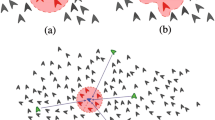Abstract
This paper analyzes the global dynamics of one-dimensional agent arrays with nearest neighbor linear couplings. The equations of motion are second-order linear ODE’s with constant coefficients. The novel part of this research is that the couplings are different for each distinct agent. We allow the forces to depend on the positions and velocity (damping terms) but the magnitudes of both the position and velocity couplings are different for each agent. We, also, do not assume that the forces are “Newtonian” (i.e. the force due to A on B equals the minus the force of B on A) as this assumption does not apply to certain situations, such as traffic modeling. For example, driver A reacting to driver B does not imply the opposite reaction in driver B. There are no known analytical means to solve these systems, even though they are linear, and so relatively little is known about them. This paper is a generalization of previous work that computed the global dynamics of one-dimensional sequences of identical agents (Cantos et al., Eur Phys J Special Topics 225:1115–1125, 2016) assuming periodic boundary conditions. In this paper, we push that method further, similar to Baldivieso and Veerman, IEEE Trans Control Network Syst (2021), and use an extended periodic boundary condition to to gain quantitative insights into the systems under consideration. We find that we can approximate the global dynamics of such a system by carefully analyzing the low-frequency behavior of the system with (generalized) periodic boundary conditions.
Graphic abstract






Similar content being viewed by others
Data Availability Statement
This manuscript has no associated data or the data will not be deposited. [Authors’ comment: Data sharing is not applicable to this article as no datasets were generated or analyzed during the current study.]
References
N.W. Ashcroft, N.D. Mermin, Solid State Physics (Saunders College, Philadelphia, 1976)
J.F. Dyson, The dynamics of a disordered linear chain. Phys. Rev. 92, 1331–1338 (1953)
E. Robert, Chandler, Robert Herman and Elliott W. Montroll, Traffic Dynamics: Studies in Car Following, Operations Research 6, 165–184 (1957)
B.S. Kerner, The Physics of Traffic (Springer-Verlag, Berlin, 2004)
U. Mackenroth, Robust Control Systems: Theory and Case Studies (Springer-Verlag, Berlin Heidelberg, 2004)
W. Ren, R. Beard, Distributed Consensus in Multi-vehicle Cooperative Control (Springer-Verlag, Berlin Heidelberg, 2008)
S.E. Li, Y. Zheng, K. Li, Y. Wu, J.K. Hedrick, F. Gao, H. Zhang, Dynamical modeling and distributed control of connected and automated vehicles: challenges and opportunities. IEEE Intell. Transp. Syst. Mag. 9, 46–58 (2017)
F. Lin, M. Fardad, M.R. Jovanovic, Optimal control of vehicular formations with nearest neighbor interactions. IEEE Trans. Autom. Control 9, 2203–2218 (2012)
R.H. Middleton, J.H. Braslavsky, String instability in classes of linear time invariant formation control with limited communication range. IEEE Trans. Autom. Control 55, 1519–1530 (2010)
H. Hao, P. Barooah, Stability and robustness of large platoons of vehicle with double-integrator models and nearest neighbor interaction. Int. J. Robust Nonlinear Control 23, 2097–2122 (2013)
C.E. Cantos, D.K. Hammond, J.J.P. Veerman, Transients in the synchronization of assymmetrically coupled oscillator arrays. Eur. Phys. J. Special Topics 225, 1115–1125 (2016)
C.E. Cantos, J.J.P. Veerman, D.K. Hammond, Signal velocity in oscillator arrays. Eur. Phys. J. Special Topics 225, 1199–1210 (2016)
J. Herbrych, A. Chazirakis, N. Christakis, J.J.P. Veerman, Dynamics of locally coupled oscillators with next-nearest-neighbor interaction. Diff. Equ. Dyn. Syst. 29(3), 487–509 (2021). https://doi.org/10.1007/s12591-017-0377-3
P.E. Baldivieso, J.J.P. Veerman, Stability conditions for coupled autonomous vehicles formations. IEEE Trans Control Netw Syst 8(1), 513–522. https://doi.org/10.1109/TCNS.2021.3052308
Author information
Authors and Affiliations
Contributions
The basic concepts were created by both authors. The main results were anticipated by both J. J. P. Veerman and R. G. Lyons. The formal proofs and simulations were constructed by R. G. Lyons with help from J. J. P. Veerman.
Corresponding author
Supplementary Information
Below is the link to the electronic supplementary material.
Rights and permissions
About this article
Cite this article
Lyons, R.G., Veerman, J.J.P. Linear nearest neighbor flocks with all distinct agents. Eur. Phys. J. B 94, 174 (2021). https://doi.org/10.1140/epjb/s10051-021-00163-2
Received:
Accepted:
Published:
DOI: https://doi.org/10.1140/epjb/s10051-021-00163-2




